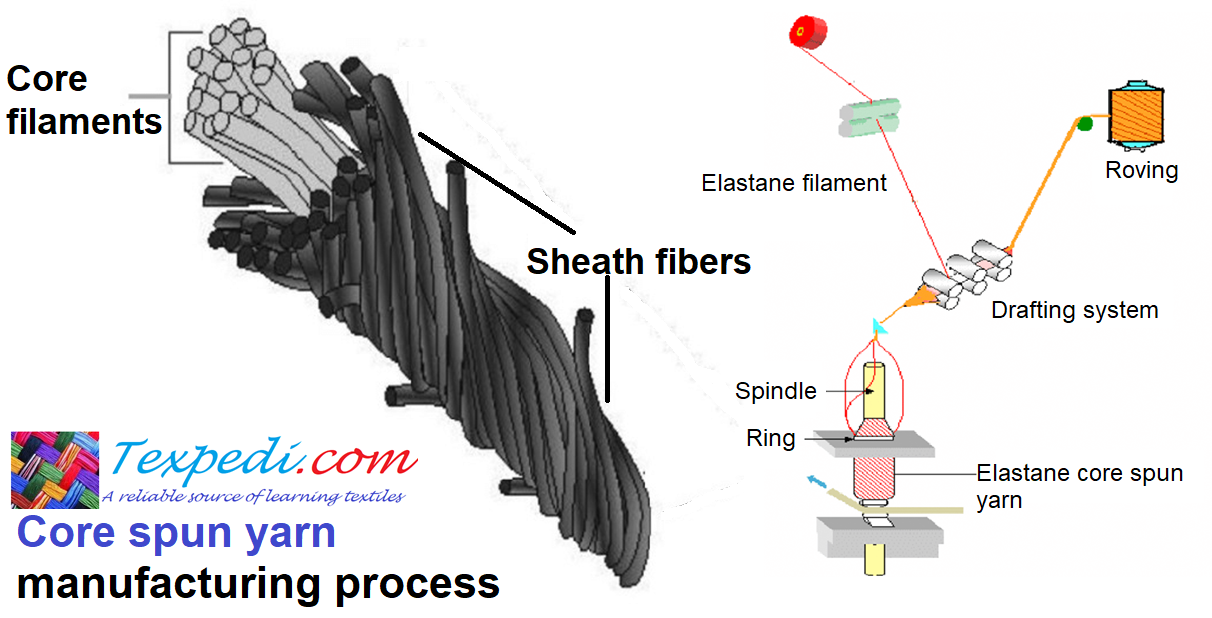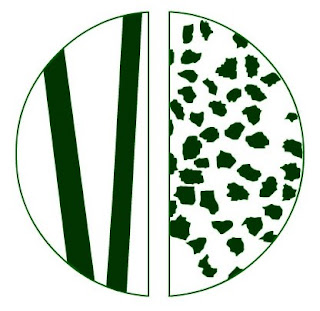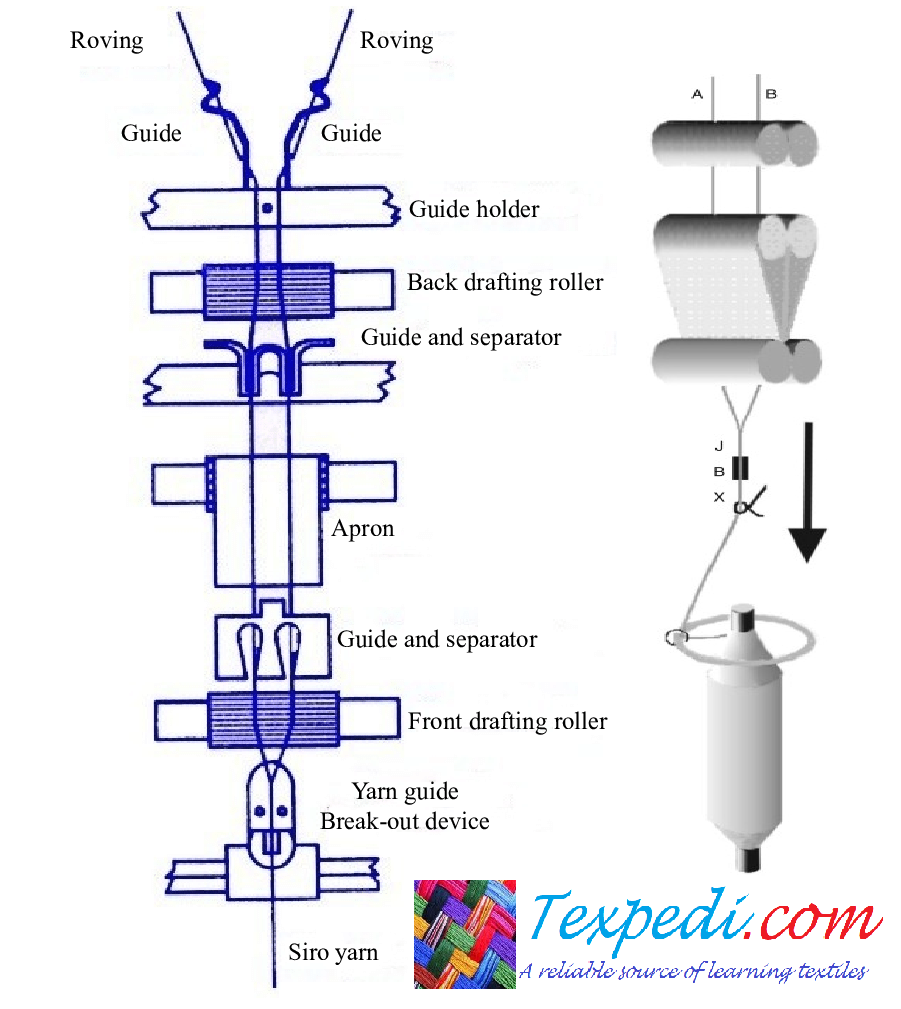Emdadul Haq
Lecturer, Department of Textile Engineering, Primeasia University; Bangladesh
Bi-component Fibres
Bi-component fibres are filaments made up of two different polymers that are extruded from the same spinneret with both polymers contained within the same filament but separated by a fine plane. The two polymers differ in chemical nature or physical properties such as molecular weight.
Why Bi-component Fibres?
The conventional fibres may not have all the desirable properties. By the use of bi-component fibres, the functional properties of both the components can be exploited in one filament. Further, the fibres can be produced in any cross-sectional shape or geometry. The properties of these bi-component fibres are governed by:
- Nature /properties of two materials.
- Their arrangement in the fibre.
- Relative proportion of the two.
- Thickness of the fibre.
Types of Bi-component Fibres
These fibres can be produced in many geometrical arrangements. On the basis of cross section, these can be classified as:
In addition to these main classes, a wide variety of bi-component fibres having different cross-sectional geometries can be produced.
Polymers of Bi-component Fiber
The polymers given below can be used as either of the components in the cross sections.
| PET (polyester) | PEN polyester |
Nylon 6,6 |
PCT polyester |
Polypropylene |
PBT polyester |
Nylon 6 |
co-polyamides |
Polylactic acid |
polystyrene |
Acetal |
polyurethane |
Soluble co polyester |
HDPE, LLDPE |
Spinning of Bi-component Fibres:
For proper spinning of two components it is required that:
- Viscosity of the two polymer fluids are comparable. The viscosity should be high enough to prevent turbulence after the spinneret
- Draw ability of the two polymers should also be comparable, otherwise splitting may occur
- Compatibility of both components with the spinning method that is melt spinning or solution spinning is also important.

The first commercial bi-component fibre was introduced by DuPont in the mid 1960s. This was a side-by-side hosiery yarn called “cantrese” and was made from two nylon polymers, which, on retraction, formed a highly coiled elastic fibre. In the 1970s, various bi-component fibres began to be made in Asia, notably in Japan. Very complex and expensive spin packs were used for manufacturing. These techniques were found to be technically unsatisfactory and excessively expensive. Later in 1989, a novel approach was developed using thin flat plates with holes and grooves to route the polymers. This process was very flexible and quite price effective.
These are melt-spun in a specially designed spinning manifold. Separate extruders and metering pumps are used for both components. Ratio of the polymers can be controlled by varying the speed of the metering pumps.
 |
| Sketch showing parts of Bi-component Spinning Machine |
1. Core-Sheath Bi-component Fibres
In core sheath structure, one of the components called core is fully surrounded by the second component known as sheath. In this configuration, different polymers can be applied as a sheath over a solid core of another polymer, thus resulting in variety of modified properties while maintaining the major fibre properties.
Concentricity/eccentricity of the core can be tuned according to end application. If the product strength is the major concern, concentric bi-component fibres are used; if bulkiness is required at the expense of strength, the eccentric type of the fibre is used.
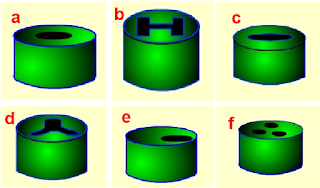 |
| Different types of bi-component fibres (a-d) Core–sheath, e) Eccentric core-sheath and f) Multiple core-sheath |
These fibres can be useful for applications where
👉Core imparts strength (reinforcing material) and sheath has dyeability, soil resistance, heat-insulating, and adhesion properties. Some examples include:
- bonding fibres used in carpets, upholstery etc., where the sheath is made of PE and core is made of high melting point material like nylon.
- antisoil-antistatic fibres, made using a PET-PEG block copolymer containing polyester core
👉Sheath can be made from expensive material to increase visual appearance. And the core can be of low cost material to control cost.
👉For making self crimping fibres. Crimp can be controlled by changing the eccentricity. Eccentricity of core can be varied to balance strength and bulkiness: used in pillows and furniture.
In a simple technique to produce core sheath fibres, the two polymer liquids are separately led to a position very close to the spinneret orifices and then extruded in a core sheath form as shown in below figure-
 |
| Technique for Core-Sheath Fibre formation |
2. Side by Side Bi-component Fibres
These fibres contain two components lying side-by-side. Both components are divided along the length into two or more distinct regions. These are generally used to make self-crimping fibres due to different shrinkage characteristics of the two components. In some applications, different melting temperatures of the fibres are taken advantage of when fibres are used as bonding fibres in thermally non-woven waves.
Generally, the two components must show good adhesion. however, side by side fibres can also be used for producing the so called split-able fibres which split in a certain processing stage yielding fine filament of a sharp edge cross section.
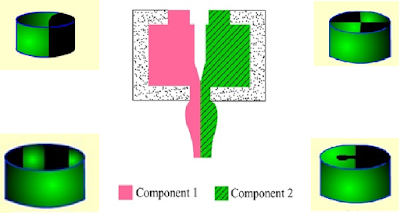 |
| Schematic showing melt spinning of side by side bi-component fibres |
3. Segmented Pie
These are made from alternate wedges made from two different polymers. The number of wedges is around 16 to 32 and the spinning manifold is complicated. The fibre is drawn to high draw ratio and sometimes splitting may occur while drawing.
The splitting is carried out by partial or complete dissolution of one component. Fibres obtained are of fine denier and sharp cross section. These are used for making non-woven web with ultra fine fibres. The resultant fabric is stronger and has higher surface area.
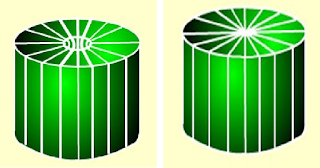 |
| Segmented pie bi-component fibres |
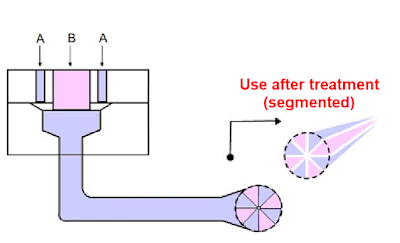 |
| Schematic showing melt spinning of segmented pie structured fibres |
PET and Nylon bi-component fibre is split by soaking in a hot caustic solution of 5-10% NaOH. PET and Nylon are separated due to swelling.
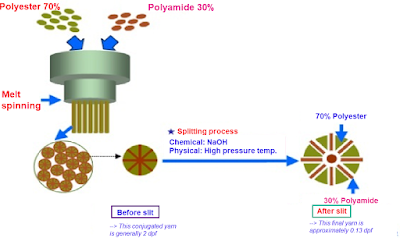 |
| Schematic showing melt spinning of segmented pie fibres |
Sanding and brushing can also be used for splitting fibres. But it works only with fibres that are easily splitable such as hollow fibre.
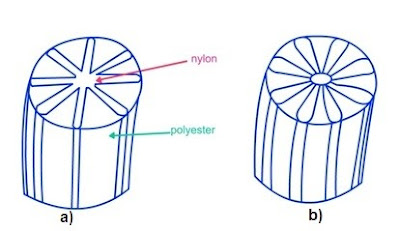 |
| Radial petal like conjugate fibres: (a) without central hole and (b) with central hole |
4. Islands in the sea
These are also called as matrix-fibril fibres. In cross section there are areas of a polymer (island) in the matrix of the other (sea).
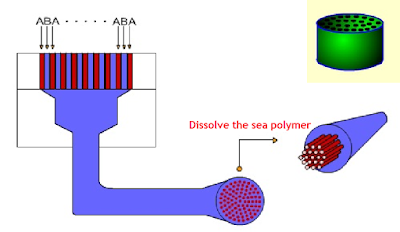 |
| Schematic showing melt spinning of islands in sea fibres |
These are also used to produce finer fibres. Sheath is made up of a dissolvable material and core is made up of desired material. Sheath is dissolved in proper solvent giving micro denier fibres.
Applications of Bi-component Fiber
The bi-component fibres can have a range of functionality and find applications for different end-uses as given in below table-
👉Antistatic: Lining clothes, workwear, knitted fabrics, underwears
👉Liquid absorbing: Sportswear, felt pens, liquid absorbers, underwears
👉Self-crimping: Stockings, beddings, heat insulators, knitted fabrics, carpets
👉Thermal Bonding: Nonwoven fabrics, beddings, mattresses, printing screens, cushions
👉Electro-conductive: Carpets, seatings, workwear, knitted fabrics
👉Light-conductive: Communication, decoration, telephone
👉Other: Enhancement of properties such as – mechanical properties, aesthetics, dye ability, water repellency, flame retardancy.
Reference:
Texpedi.com
Check out these related articles:


